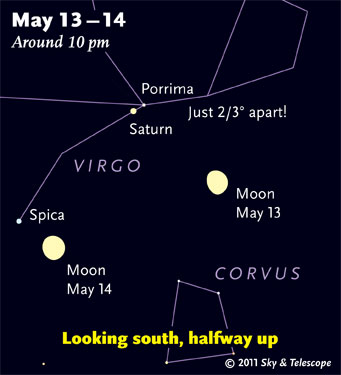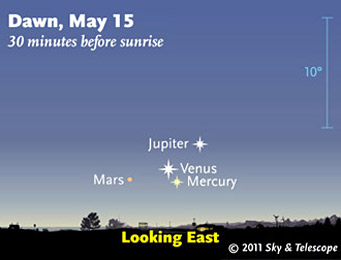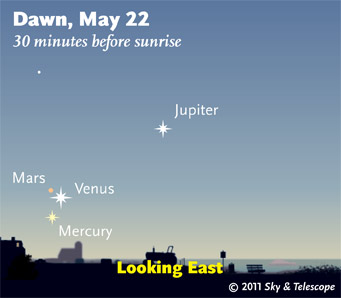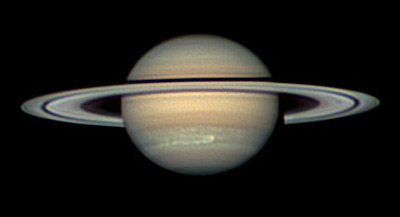
The waxing gibbous Moon passing under Saturn and Spica.
Sky & Telescope diagram
Friday, May 13
See the May 15th scene below. For a view of the planets' changing positions every morning this month, see our article and animation. You can pause the animation at any date.
Saturday, May 14

Mercury has brightened in the last week to form a fine triangle with Venus and Jupiter in the dawn, but Mars remains (probably) a binocular object at best.
Sky & Telescope diagram
Sunday, May 15
Monday, May 16
Tuesday, May 17
Wednesday, May 18
Thursday, May 19

Now that Jupiter is higher and easier to see, you can use it as a guide to locating the other three dawn planets.
These scenes are always drawn for 40° north latitude. If you're south of there, the view will be rotated counterclockwise by roughly your difference from 40° latitude. (The visibility of objects in bright twilight is exaggerated.)
Sky & Telescope diagram
Friday, May 20
Saturday, May 21
Want to become a better amateur astronomer? Learn your way around the constellations. They're the key to locating everything fainter and deeper to hunt with binoculars or a telescope.
For an easy-to-use constellation guide covering the whole evening sky, use the big monthly map in the center of each issue of Sky & Telescope, the essential magazine of astronomy. Or download our free Getting Started in Astronomy booklet (which only has bimonthly maps).

The Pocket Sky Atlas plots 30,796 stars to magnitude 7.6 — which may sound like a lot, but that's less than one star in an entire telescopic field of view, on average. By comparison, Sky Atlas 2000.0 plots 81,312 stars to magnitude 8.5, typically one or two stars per telescopic field. Both atlases include many hundreds of deep-sky targets — galaxies, star clusters, and nebulae — to hunt among the stars.
Sky & Telescope
Once you get a telescope, to put it to good use you must have a detailed, large-scale sky atlas (set of charts). The standards are the Pocket Sky Atlas, which shows stars to magnitude 7.6; the larger Sky Atlas 2000.0 (stars to magnitude 8.5); and the even larger and deeper Uranometria 2000.0 (stars to magnitude 9.75). And read how to use sky charts effectively.
You'll also want a good deep-sky guidebook, such as Sky Atlas 2000.0 Companion by Strong and Sinnott, or the more detailed and descriptive Night Sky Observer's Guide by Kepple and Sanner, or the classic if dated Burnham's Celestial Handbook.
Can a computerized telescope take their place? I don't think so — not for beginners, anyway, and especially not on mounts that are less than top-quality mechanically. As Terence Dickinson and Alan Dyer say in their Backyard Astronomer's Guide, "A full appreciation of the universe cannot come without developing the skills to find things in the sky and understanding how the sky works. This knowledge comes only by spending time under the stars with star maps in hand."
This Week's Planet Roundup
Mercury, Venus, Mars, and Jupiter continue their evolutions low in the bright glow of dawn. Use binoculars 30 minutes before sunrise; look low in the east. Venus is the brightest. Second-brightest is Jupiter, now moving farther to Venus's upper right. Below Venus by about 1 ½° is Mercury, still brightening. Faint little Mars is a real challenge object to their left or lower left.
See our article "The Four-Planet Dance of 2011" about the whole month of this dawn parade, with daily panels in an animation. You can pause the animation at your date of choice.

Saturn's white spot continues re-erupting! The head of the pale streamer wrapping around the planet has rebrightened with new upwelling material, as seen in this image taken by Christopher Go on May 12th (at 13:32 UT; System III central-meridian longitude 314°). "The old and new materials are interacting, forming bright and complex features," he writes. South here is up.
Also see his gif animation or wmv animation of several more images taken over the course of 84 minutes, confirming dark spoke markings on the celestial east (following) side of the bright B ring. In the animations, north is up.
Saturn (magnitude +0.6, in Virgo) is the only planet in good telescopic view. Look for it high in the south-southeast as the stars come out, with Spica to its lower left and bright Arcturus nearly twice as far to its left. Saturn is highest in the south not long after dark.
In a telescope Saturn's rings are 7.6° from edge on, nearly their minimum tilt for this year and for more than a decade to come. The rings are casting a relatively wide, prominent black shadow southward onto the globe, and the globe's shadow on the rings is visible just off the globe's celestial east (following) side. Saturn's months-old white streak is still active, as seen here. See how many of Saturn's satellites you can identify in your scope using our Saturn's Moons tracker.
Saturn has now closed to about 3/4° from fainter Gamma Virginis (Porrima). This star is an attraction in its own right: a fine, close telescopic binary with a current separation of 1.7 arcseconds. Use high power and hope for good seeing. See the article in the April Sky & Telescope, page 56. Saturn will pass 0.4° from Gamma Vir in mid-June.
Uranus (magnitude 5.9, in western Pisces) is very low in the east just before the first light of dawn.
Neptune (magnitude 7.9, in Aquarius) is in the southeast just before dawn.
All descriptions that relate to your horizon — including the words up, down, right, and left — are written for the world's mid-northern latitudes. Descriptions that also depend on longitude (mainly Moon positions) are for North America. Eastern Daylight Time (EDT) equals Universal Time (also known as UT, UTC, or GMT) minus 4 hours.
To be sure to get the current Sky at a Glance, bookmark this URL:
http://SkyandTelescope.com/observing/ataglance?1=1
If pictures fail to load, refresh the page. If they still fail to load, change the 1 at the end of the URL to any other character and try again.
 0
0
Comments
You must be logged in to post a comment.